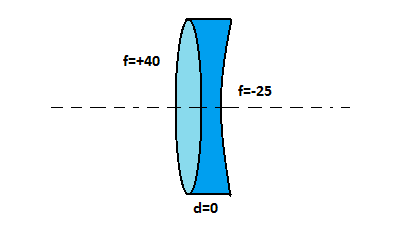Answer
414.6k+ views
Hint:The power of lens is the inverse of the focal length of the lens in meters. For a system of lenses the power of the system is known as equivalent power for the system.
Complete solution:
Convex lens:
An optical instrument which is a part of two imaginary spheres, which is transparent and has both the faces bulging outwards, is called a convex lens.
The convex lens converges the rays parallel to its principal axis and incident on it. It has a positive focal length.
So let the focal length of our convex lens be ${f_1}$ and so ${f_1} = + 40cm$
Concave lens:
An optical device that is a part of two imaginary spheres, which is transparent and the faces bulging inside, is called a concave lens.
The concave lens unlike the convex lens diverges the rays’ incident on it and is parallel to the principal axis. The focal length of a concave lens is negative.
So let the focal length of our concave lens be ${f_2}$ and so ${f_2} = - 25cm$.
Power of lens:
The power of a lens is measured in Diopters and is the inverse of its focal length;
$P = \dfrac{1}{f}$
Thus if ${P_1}$ and ${P_2}$ are the powers of the convex and concave lenses respectively then we have,
$$${P_1} = \dfrac{1}{{{f_{ & 1}}}}$ and ${P_2} = \dfrac{1}{{{f_2}}}$ respectively
But here are system is a combination of two systems and so, the equivalent power of the system is given by;
${P_{eq}} = {P_1} + {P_2} - d{P_1}{P_2}$
Here d is the distance between the two lenses.

The diagram above will help you understand the situation. As you can see the distance between the two lenses is zero we have d = 0
Hence the equivalent power of the system is given by;
${P_{eq}} = {P_1} + {P_2} - d{P_1}{P_2}$
\[ \Rightarrow {P_{eq}} = {P_1} + {P_2} - 0\]
$ \Rightarrow {P_{eq}} = \dfrac{1}{{{f_1}}} + \dfrac{1}{{{f_2}}}$
Thus, substituting values we get;
$ \Rightarrow {P_{eq}} = \dfrac{{100}}{{ + 40}} + \dfrac{{100}}{{ - 25}}$
$\therefore {P_{eq}} = - 1.5D$
Therefore option B is correct.
Note:
The equivalent focal length of the system can also be calculated.
It is given by ${f_{eq}} = \dfrac{{{f_1}{f_2}}}{{{f_1} + {f_2} - d}}$.
As you can see power decreases with increase in the distance between the lenses.
The above formula is valid for a two lens system, for a system with more lenses try making pairs and solving it with the same approach.
Complete solution:
Convex lens:
An optical instrument which is a part of two imaginary spheres, which is transparent and has both the faces bulging outwards, is called a convex lens.
The convex lens converges the rays parallel to its principal axis and incident on it. It has a positive focal length.
So let the focal length of our convex lens be ${f_1}$ and so ${f_1} = + 40cm$
Concave lens:
An optical device that is a part of two imaginary spheres, which is transparent and the faces bulging inside, is called a concave lens.
The concave lens unlike the convex lens diverges the rays’ incident on it and is parallel to the principal axis. The focal length of a concave lens is negative.
So let the focal length of our concave lens be ${f_2}$ and so ${f_2} = - 25cm$.
Power of lens:
The power of a lens is measured in Diopters and is the inverse of its focal length;
$P = \dfrac{1}{f}$
Thus if ${P_1}$ and ${P_2}$ are the powers of the convex and concave lenses respectively then we have,
$$${P_1} = \dfrac{1}{{{f_{ & 1}}}}$ and ${P_2} = \dfrac{1}{{{f_2}}}$ respectively
But here are system is a combination of two systems and so, the equivalent power of the system is given by;
${P_{eq}} = {P_1} + {P_2} - d{P_1}{P_2}$
Here d is the distance between the two lenses.

The diagram above will help you understand the situation. As you can see the distance between the two lenses is zero we have d = 0
Hence the equivalent power of the system is given by;
${P_{eq}} = {P_1} + {P_2} - d{P_1}{P_2}$
\[ \Rightarrow {P_{eq}} = {P_1} + {P_2} - 0\]
$ \Rightarrow {P_{eq}} = \dfrac{1}{{{f_1}}} + \dfrac{1}{{{f_2}}}$
Thus, substituting values we get;
$ \Rightarrow {P_{eq}} = \dfrac{{100}}{{ + 40}} + \dfrac{{100}}{{ - 25}}$
$\therefore {P_{eq}} = - 1.5D$
Therefore option B is correct.
Note:
The equivalent focal length of the system can also be calculated.
It is given by ${f_{eq}} = \dfrac{{{f_1}{f_2}}}{{{f_1} + {f_2} - d}}$.
As you can see power decreases with increase in the distance between the lenses.
The above formula is valid for a two lens system, for a system with more lenses try making pairs and solving it with the same approach.
Recently Updated Pages
How many sigma and pi bonds are present in HCequiv class 11 chemistry CBSE

Why Are Noble Gases NonReactive class 11 chemistry CBSE

Let X and Y be the sets of all positive divisors of class 11 maths CBSE

Let x and y be 2 real numbers which satisfy the equations class 11 maths CBSE

Let x 4log 2sqrt 9k 1 + 7 and y dfrac132log 2sqrt5 class 11 maths CBSE

Let x22ax+b20 and x22bx+a20 be two equations Then the class 11 maths CBSE

Trending doubts
Fill the blanks with the suitable prepositions 1 The class 9 english CBSE

At which age domestication of animals started A Neolithic class 11 social science CBSE

Which are the Top 10 Largest Countries of the World?

Give 10 examples for herbs , shrubs , climbers , creepers

Difference between Prokaryotic cell and Eukaryotic class 11 biology CBSE

Difference Between Plant Cell and Animal Cell

Write a letter to the principal requesting him to grant class 10 english CBSE

Change the following sentences into negative and interrogative class 10 english CBSE

Fill in the blanks A 1 lakh ten thousand B 1 million class 9 maths CBSE



